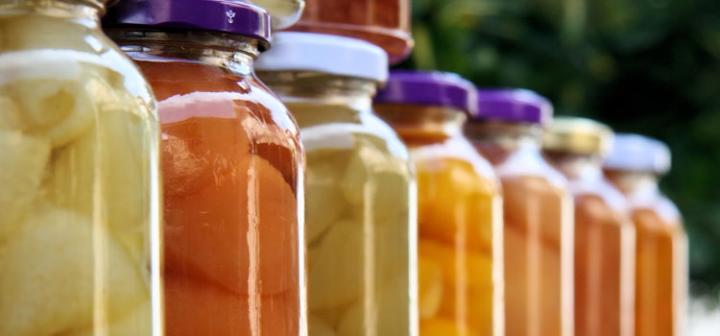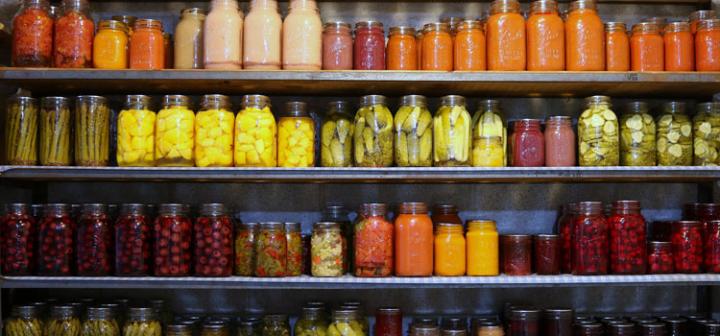Plant to fill the cupboard
Grow some vegetables that can be enjoyed long after the gardening season is done. If you wish to plant for the pantry—whether for freezing, preserving, or canning—see which crops to grow and which ones store well for year-round enjoyment.
Focus on Failsafe Crops
First, consider how long crops take to reach harvest. This way, you can spot where gaps will appear once your first crops are finished and can plan to replace them with more, keeping your garden productive for longer. Our Garden Planner can help you work out when and where gaps will appear in your garden as crops are harvested.
Focus your initial efforts on reliable, easy-to-grow crops such as tomatoes, peppers, onions, cucumbers, and beans. These will form the bulk of your stored produce but should also provide enough for fresh eating. Pick varieties that are known to perform reliably in your location. For example, if you garden in a hot climate and want to grow tomatoes, you’ll need to source heat-tolerant varieties. But if your summers are typically cool and overcast, seek out cool-climate varieties bred for just such conditions.

The Right Crops for Storing
Bear in mind your soil type, too. You might, for example, have grand plans to freeze bushels of blueberries, but if your soil isn’t acidic, you won’t be able to grow them in any serious quantity without resorting to lots and lots of containers filled with ericaceous compost – so concentrate on what grows best in your garden.
As well as choosing varieties appropriate for your climate and soil, pick those best suited for what you have in mind. For example, if you hope to make lots of tomato sauce for the freezer, grow a paste tomato such as ‘Roma’ that cooks down well. Or perhaps you want to make some pickles? Then, grow smaller pickling cucumbers that will fit into jars.
While all of this produce is destined to be stored in some way, it’s still worth staggering planting times to spread out harvests. A clutch of cucumbers or a bonanza of beets is a joy to behold, but if everything is ready for processing at the same time, it can become unmanageable. Dealing with gluts like this is time-consuming and not particularly fun.

Fruit for Preserving
Fruit trees and bushes yield lots of produce for minimal effort on the gardener’s part. They’re a must for filling the store cupboard. Plant a range of varieties to extend the harvest period and make processing what you pick more manageable. As an example, the earliest varieties of plum ripen in midsummer; there are some to pick in late summer, while the last varieties to ripen aren’t ready to harvest until autumn.
Plant varieties and types of fruit that you love but which aren’t readily available in the grocery store. Crab apples, for instance, are impossible to find in the shops but are a fantastic ingredient for homemade preserves.
Berries and currants of all kinds are ideal for canning, freezing, and preserving. They are easy to grow yet expensive to buy, which makes them a very worthwhile addition to your garden. Don’t overlook blackberries. These vigorous canes look great trained up a pergola or screen. All of these soft fruits are relatively trouble-free, though if you plan on growing a lot of fruit, you might like to consider planting them in a fruit cage to prevent the birds from beating you to it.
Pick fruit as it ripens, and refrigerate what you’ve picked until you have enough to make a batch of preserves.
Make Smart Use of Your Growing Space
When planning any productive garden, aim to plant the most labor-intensive crops closest to your house, while crops needing less attention, such as fruit bushes, can be grown further away. Tomatoes, for example, need regular watering, feeding, and inspecting for pests. If they are nearer the house, you’ll be more inclined to pop outside and tend them. Locate herbs close by, too, so they are always on hand to add to recipes, including preserves and canned produce.
Make use of garden microclimates to push the boundaries. For instance, a sheltered, sun-facing wall will help apricots ripen in temperate climates, and it’s amazing how even a fig will thrive, given a warm, sun-drenched corner.
Finally, stock up on all the extra ingredients necessary to process all of the fantastically fresh produce that will be heading your way.
Storing some of the growing season’s harvests is a wise move, and one that will help you take another step towards self-sufficiency. Popping open a jar of garden-grown goodness in the depths of winter is priceless!
Try Out the Almanac Garden Planner for Free
As a courtesy, the online Almanac Garden Planner is free for seven days. This is plenty of time to play around on your computer and try it out. There are absolutely no strings attached. We are most interested in encouraging folks to try growing a garden of goodness!
ADVERTISEMENT








